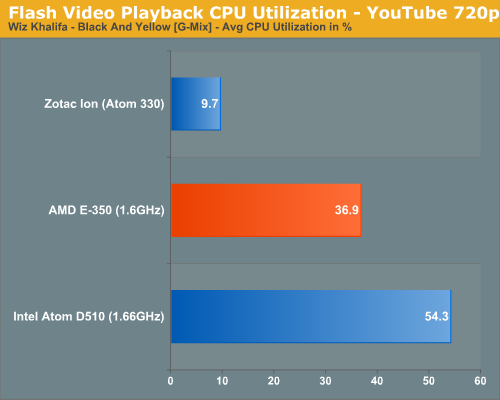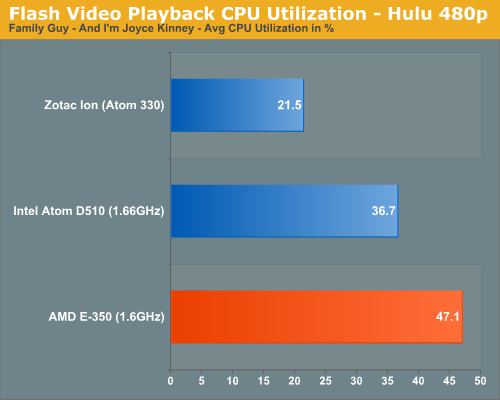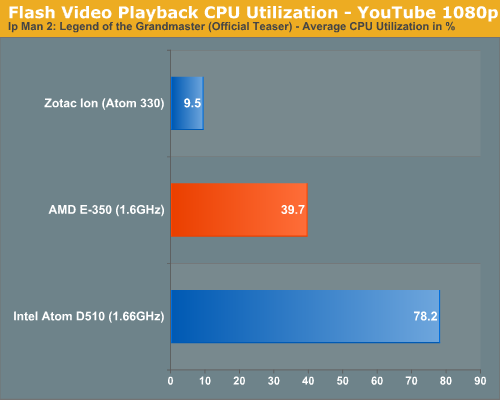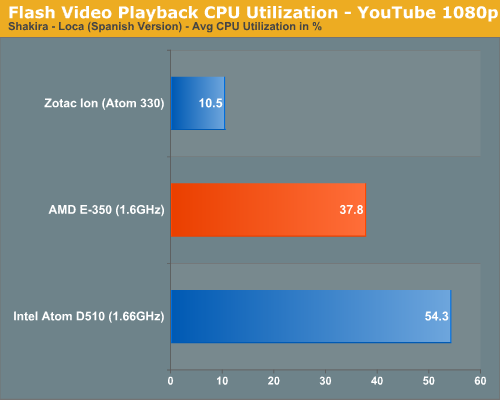The Brazos Review: AMD's E-350 Supplants ION for mini-ITX
by Anand Lal Shimpi on January 27, 2011 6:08 PM ESTBlu-ray & Flash Video Acceleration
Compatibility is obviously a strongpoint of Brazos. So long as what you’re decoding can be hardware accelerated you’re pretty much in the clear. But what about CPU utilization while playing back these hardware accelerated formats? The CPU still needs to feed data to the GPU, how many cycles are used in the process?
I fired up a few H.264/x264 tests to kick off the investigation. First we have a 1080p H.264 Blu-ray rip of Quantum of Solace, averaging around 15Mbps:
| Quantum of Solace 1080p H.264 CPU Utilization (1:00 - 1:30) | |||||
| Platform | Min | Avg | Max | ||
| AMD E-350 | 22.7% | 27.8% | 35.3% | ||
| Intel Atom D510 | Fail | ||||
| Zotac ION | 14.6% | 17.2% | 20.1% | ||
A standard Atom platform can’t decode the video but ION manages a 17% average CPU utilization with an Atom 330. Remember that the Atom 330 is a dual-core CPU with SMT (4-threads total) so you’re actually getting 17.2% of four hardware threads used, but 34.4% of two cores. The E-350 by comparison leaves 27.8% of its two cores in use during this test. Both systems have more than enough horsepower left over to do other things.
Next up is an actual Blu-ray disc (Casino Royale) but stripped of its DRM using AnyDVD HD and played back from a folder on the SSD:
| Casino Royale BD (no DRM) CPU Utilization (49:00 - 49:30) | |||||
| Platform | Min | Avg | Max | ||
| AMD E-350 | 28.1% | 33.0% | 38.4% | ||
| Intel Atom D510 | Fail | ||||
| Zotac ION | 17.7% | 22.5% | 27.5% | ||
Average CPU utilization here for the E-350 was 33% of two cores.
Finally I ran a full blown Blu-ray disc (Star Trek) bitstreaming TrueHD on the E-350 to give you an idea of what worst case scenario CPU utilization would be like on Brazos:
| Star Trek BD CPU Utilization (2:30 - 3:30) | |||||
| Platform | Min | Avg | Max | ||
| AMD E-350 | 29.0% | 40.1% | 57.1% | ||
At 40% CPU utilization on average there’s enough headroom to do something else while watching a high bitrate 1080p movie on Brazos. The GPU based video decode acceleration does work, however the limits here are clear. Brazos isn’t going to fare well as a platform you use for heavy multitasking while decoding video, even if the video decode is hardware accelerated. As a value/entry-level platform I doubt this needs much more explanation.
Now let’s talk about Flash.
I ran through a number of Flash video tests at both YouTube and Hulu ranging in resolution from 480p all the way up to 1080p. I used Flash 10.1, 10.2 beta as well as an unreleased version of 10.2 beta provided by AMD.


For the most part GPU accelerated Flash video does work well. Performance under both YouTube and Hulu was flawless, provided that I wasn’t watching 1080p content. Watching 1080p content in YouTube wasn’t entirely smooth on Brazos, despite posting very reasonable CPU utilization numbers.


I took my concerns to AMD and was told that this was a known issue with Brazos and Flash 10.1 and that 10.2 should alleviate the issue. AMD then supplied me with an unreleased version of Flash 10.2 to allow me to verify its claims. While 1080p playback improved with AMD’s 10.2 beta, it wasn’t perfect (although it was very close). AMD wouldn’t tell me the cause of the problem but it’s currently working on it with Adobe. At the end of the day I don’t believe it’s a dealbreaker, but early Brazos adapters should expect some stuttering when playing back 1080p YouTube videos. Note that 720p and lower resolution videos were perfectly smooth on Brazos.










176 Comments
View All Comments
Belard - Tuesday, February 1, 2011 - link
It would fail at bluRay 3D.the 1080i is a bit unimportant since flatscreen TVs don't do interlace.
doctorpink - Tuesday, February 1, 2011 - link
if i remember correctly, nano runs 1.8ghz and is much faster but more power hungry...are there netbooks with nano anyway?
grego3d - Tuesday, February 1, 2011 - link
I'm sold on this Sandy Bridge / Atom killer. Well, maybe not Sandy Bridge killer yet, but i'm sure the second generation fusion processors will be. Now I need help finding a great little mini-itx case. I'd love to build a mini pc the size of my Wii. I have found a few small cases, but where on earth are the slot feed DVD/BD players. I always start my daily reading right here @ Anandtech.com so please save me some time and help us all out by rounding up a case review for this new Fusion platform. Go AMD Fusion - Boo Intel (and your 1$Billion oops!)Belard - Tuesday, February 1, 2011 - link
Sure is such excitement over such a tiny chip.It also reminds me why one of the P4s Dells I use at work is sooooooooooo Slooooooooooooooow.
I'll admit I'm using my very old computer (AMD X2 3800) as an HTPC somewhat, since it wasn't worth selling when I upgraded. But its a 90watt CPU... so saving power is the big thing, eh?
lovansoft - Tuesday, February 1, 2011 - link
I've got an Acer Aspire 5517 with an AMD Athlon tk-42 processor and integrated HD3200 video. It's also 1.6 Ghz so I wanted to showcase a relative clock for clock comparison. It is a 20W chip with 1meg cache built on a 65nm process and no VT. It's not an Athlon II, just an Athlon 64 x2, I believe.On Cinebench R10:
Single Thread: E-350=1174, TK-42=1340 :-: 1174/1340 = 87.6%
2 Threads: E-350=2251, TK-42=2373 :-: 2251/2373 = 94.4%
(1174+2251=3425)/(1340+2373=3713) = 92.2%
Scaling seems better on the new chips than on the older ones.
At idle with the screen off the laptop pulls about 18 watts. In Cinebench on a single thread it pulls about 30 watts, with 2 threads it pulls about 33 wats. Opening the screen to run the LCD at full brightness adds about 9 watts at any time.
I ran these tests with a Kill-A-Watt meter. It's not quite an exact comparison, but is pretty close. But to see that they kept performance close, added graphics, and still managed to shave 10% off TDP it's pretty dang impressive.
lovansoft - Tuesday, February 1, 2011 - link
Actually, I just let my laptop sit idle for a while. Now, idle power usage dips down to 11 watts with the lid closed and generally stays switching between 11-13 watts. Hmmm, the power usage on these new chips aren't quite as I would expect unless it's a platform thing. This article shows that the new chips pull 9W at full load under Cinebench. My testing shows I ramp from about 12W up to 33W which is a 21W increase by taxing the TK-42, right inline with the 20W spec giving my rounding of numbers. All other parts being equal and I only ramp up 9W instead of 21W then my peak should be about 12W less, or about 21W total instead of 33W total. That would be a significant gain. Interesting that this article has the new platform at 32.2W with the same workload. That's about 50% higher than my rough estimations. Is it because it's a desktop board and not a laptop design?sebanab - Wednesday, February 2, 2011 - link
Thanks for the performance comparison. I really helps putting the Zacate into perspective.On the power consumption comparison:
Ofcourse the desktop board system will consume more than a laptop with same specs.
Your laptop consumes less because of different PSU , less USBs , less components in general (PCIex) and so on.
So in order to make a correct comparison , wait for a HP DM1z review for example.
lovansoft - Wednesday, February 2, 2011 - link
I figured as much, but 50% seems high. But then again, it really is only a few watts... Lower efficiency PSU, a couple more chips to provide some extra ports. A couple of watts here and there do add up I suppose. And to think it provides more than 90% of my current performance into only 2/3 the power. I'd think if they can up it to 2Ghz it'd be about the same as mine without tapping the power too much. From the speculation I've read, it makes it seem that the revision coming in a year should grow the performance by quite a bit without really increasing power, about what you'd expect from a die shrink.You know, with this architecture, it'd be nice if a board could be made that would have multiples of these chips for server use. From my experience in SMB, I rarely find servers being CPU bound. Usually if they are, then there is some runaway process that needs to be tamed. Maybe this current generation isn't quite fast enough, but with a process shrink and some speed adjustments, getting a few of these on a board would make a very low energy server. But it'd only be feasible if there were something they could use that built in graphics portion for. Otherwise it'd be a waste.
Oh, and Cinnebench R10 on an AthlonXP 3000+ (2Ghz) = 1438.
Single Thread: E-350=1174, XP3000=1438 :-: 1174/1438 = 81.6%
1.6/2=80% Seems to be about the same IPC as the AthlonXP line.
I don't have power numbers for it, though.
torkemada - Wednesday, February 2, 2011 - link
Is E350IA-E45 board HDMI 1.4? Info on the net is confusing.Hrel - Thursday, February 3, 2011 - link
that VIA chip is pretty impressive.